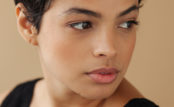 Profollica is a natural two or optional three-step system designed to help men reduce genetic hair loss. The product is ideal for guys looking for a natural way to address the cause of male pattern baldness – excessive levels of dihydrotestosterone (DHT). Yet, with roughly 60%of American women over 70 struggling with female hair loss, we’re frequently asked another question:
Profollica is a natural two or optional three-step system designed to help men reduce genetic hair loss. The product is ideal for guys looking for a natural way to address the cause of male pattern baldness – excessive levels of dihydrotestosterone (DHT). Yet, with roughly 60%of American women over 70 struggling with female hair loss, we’re frequently asked another question:
Can women use Profollica?
They can, but we don’t recommend it, and here’s why: male and female hair loss are different creatures. Men tend to experience hair loss at a younger age – typically beginning by 35 or younger – with thinning at the hair line and crown. That’s in contrast to the slower, general thinning the average woman experiences.
The female physiology is a dance of different hormones, too. While androgens may account for much female hair loss, women can lose hair for a variety of reasons, some genetic, some not. Profollica is formulated for male hair loss, which tends to be more predictable: high levels of DHT account for roughly 95% of hair loss in guys.
So How Do You Address Female Hair Loss?
Methodically. While you can’t avoid genetic hair loss, you can certainly do your part to encourage growth of healthy hair and to maintain what you have. The FDA approves Minoxidil (Rogaine) for women and hair transplants – previously slanted more towards male hair loss – are now an option for women as the procedure continues to improve.
But your first priority should be to identify whether genes or an underlying health issue is the culprit.
1) Look For Non-Genetic Hair Loss
This depends on several factors, but they hinge on how quickly the hair loss occurs. Genetic hair loss among women is usually slower, typically not visible until the 50s or 60s. Meaning? Rapid hair loss in women is often non-genetic. And fortunately, it’s often reversible.
You’ll want to speak with your doctor in this scenario. Rapid hair loss in may indicate a more urgent health issue, like hyperandrogenism – excess production of male sex hormones, which is often caused by polycystic ovary syndrome (POS). Further symptoms of the latter include acne, obesity, and irregular menstruation. POS is a common cause of infertility and should be treated.
Other non-genetic causes of female hair loss include pregnancy, thyroid disorders, anemia, autoimmune diseases and skin conditions like psoriasis and seborrheic dermatitis. Stress, surgery, rapid (and dramatic) weight loss and too much vitamin A can also cause hair loss, during, weeks or sometimes months after the event.
Your doctor may need to diagnose hair loss from any one of these issues. These conditions are generally more urgent than the hair loss they cause, which should rectify itself.
2) Eat Hair-Friendly Foods
You’ll also want to watch your diet and opt for foods that make hair grow. Yes, some foods encourage hair growth – albeit the right foods, preferably high in zinc, copper and plenty of protein. Find those and other beauty foods in the outer aisles of the supermarket. Hair-friendly foods include:
Salmon: You’ll be hard-pressed to find a healthier food than wild salmon, with its high levels of omega-3 fatty acids, vitamins B12, iron and protein. Your hair may be shinier too – studies suggest that omega-3 deficiency can lead to dry scalp.
Dark, Green Vegetables: Popeye may not come to mind when you think of luscious locks, but that’s no fault of his diet. Spinach bursts with vitamins A and C, which helps the follicles produce an oil called sebum. This is the body’s natural hair conditioner, further helped by the iron and calcium in spinach and other dark greens, including broccoli and Swiss chard.
Beans: Surprised? Consider this – legumes like kidney beans and lentils and rich in protein, iron and biotin, with the latter being an ingredient in Profollica.
Nuts: Another under-appreciated source of nutrition, Brazil nuts are an excellent source of hair-encouraging selenium. Walnuts are way up there too in the hair growth department, along with cashews, pecans and almonds, all being high in zinc, of which a deficiency can lead to excess hair loss.
Poultry: Hair is mostly protein, so it’s easy to see how protein deficiency or low quality protein can lead to breakage and loss of hair color. You might avoid that with poultry, like chicken or turkey breast, both having high bioavailability of protein, which means your body can use it more efficiently than from other foods.
Eggs: Speaking of protein, eggs are full of it, with a hefty helping of biotin and vitamin B12. You can serve them any way you like, too, and still get those hair-growing nutrients.
Whole Grains: Opt for whole grain breads and cereal and you’ll enjoy plenty of zinc, iron and B vitamins. You know what that means – good hair growth with shine thrown in for good measure.
Oysters: An aphrodisiac that might have a pearl inside. If that wasn’t enough to add oysters to your plate, consider also that it’s one of the best hair-growing foods because it’s high in follicle-friendly zinc.
Please note these foods should be part of an overall balanced diet, with lean proteins, fruits and vegetables, whole grains, legumes, fatty fish and low-fat dairy sources like skim milk and yogurt. Avoid fad and crash diets that starve the body of nutrients and affect the hair-growing cycle. Eat these foods as part of an ongoing commitment to health and better living to enjoy them in all their hair-growing potential.
3) Consider Hair Transplants
Previously a treatment marketed to men with hair loss, hair transplant technology is evolving and allows for greater density and less time required to perform the procedure. The tools are improving too, which means surgeons can do the procedure with less concern of damaging tissue.
A hair transplant is a cosmetic procedure in which surgeons remove a strip of hair from the lower scalp, just above the neck. Called the ‘donor site’ this area is not genetically prone to hair loss, which allows the team to remove hundreds of skin graphs from this strip and insert them into incisions made throughout the scalp, or ‘recipient area’.
The transplanted hair typically falls out within three weeks to a month, then grows back after roughly six months.
While early hair transplants looked ‘pluggy’, and the procedure was one of the most labor-intensive of all cosmetic surgeries, improvements to grafting technology allow surgeons to plant more hair into each graft. A standard ‘session’ of 400-500 grafts can be performed in under three hours. The more comprehensive mega-session, of 3000-4000 grafts, may take up to ten hours, with a price tag that may exceed $10,000.
The latter may sound daunting, but keep in mind this ‘mega-session’ may be the better option for women because they tend to experience a broad thinning that would benefit from more grafts, and the new technology that allows surgeons to pack more hair in each one. And the numbers reflect it – according to Michael Reed of the New York University Medical Center’s hair clinic, 30% of his hair transplant patients are women, up from about 5% in the 1990s.
4) Blend Hair Loss Into Your Style
Hair transplants aren’t the cheapest way to address hair loss in women, nor are they suited to everyone. Most women experience minor hair loss, later in life. That’s good news, because you might conceal thinning hair with styling techniques. These include:
Color Your Hair: Try a permanent or semi-permanent color to give body and volume to your hair. Semi-permanent color may interest patients with hair loss from medications because it has no ammonia or peroxide, while women with fine hair might want to have color professionally applied for risk of making hair loss worse.
Use Mousse or Other Volume Products: Apply a volumizing product like mousse at the roots, after which you can blow dry the area, apply tension with a brush and use a light finishing spray for hold. Note to avoid volumiuzing products with parrafin – beeswax – which can build up and cause breakage. Opt for products bought in a salon, which tend to be higher quality.
 Handle Fine Hair With Care: While blow dryers should not be a problem, women with fine hair should avoid high heat, especially from flat irons and curling irons. Speak with a stylist about how to find a hair style for your texture.
Handle Fine Hair With Care: While blow dryers should not be a problem, women with fine hair should avoid high heat, especially from flat irons and curling irons. Speak with a stylist about how to find a hair style for your texture.
Try a Permanent Wave: Fine-haired women might also consider a permanent wave, which can add further volume. Be aware that permanents tend to have harsh chemicals, which can damage hair, and should only be done as a last resort. You’ll need healthy hair for this too, not dry or brittle. Have this done professionally if you pursue this option.
Conclusion
You’ve got options if you’re a women with hair loss. We don’t recommend Profollica for women, but speak with your doctor for more information. Profollica works well for men – it’s not impossible that it could work for you too.
At present, Rogaine is the only hair loss medication for women approved by the FDA. And women of child-bearing age should avoid finasteride (Propecia) completely because it may damage the male fetus.
Try the tips we’ve reviewed in this article. Review any medications that could be causing hair loss with your doctor and screen for other, more urgent conditions that may be responsible. Your health comes first, after all. Everything else is trivial.
Keep in mind that your doctor can confirm if your hair loss is genetic by observing your follicles with a magnifying glass. If some are larger than others, and the women in your family also have thin hair, it’s a good bet your hair loss is genetic.
So live well. Eat a hair-friendly diet and abstain from habits that can accelerate hair loss, like smoking. While we don’t go out of our way to recommend Profollica for women, the choice is yours if you’re keen to do so, and your doctor agrees. You can also consider transplants and manage your hair with good styling tips. Do these things and you’ll probably find your hair loss is minimal – and manageable.




